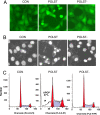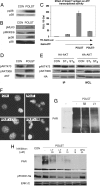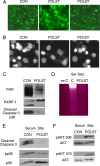Protein phosphatase 2A regulates life and death decisions via Akt in a context-dependent manner
- PMID: 18006659
- PMCID: PMC2141899
- DOI: 10.1073/pnas.0706696104
Protein phosphatase 2A regulates life and death decisions via Akt in a context-dependent manner
Abstract
Here, we show how targeting protein phosphatase 2A (PP2A), a key regulator of cellular protein phosphorylation, can either induce or prevent apoptosis depending on what other signals the cell is receiving. The oncoprotein polyoma small T interacts with PP2A to regulate survival. In the presence of growth factors, small T induces apoptosis. Akt activity, which usually promotes survival, is required for this death response, because inhibitors of Akt or PI3 kinase protect cells from death. The activation of Akt under these conditions is partial, characterized by T308 phosphorylation but not S473 phosphorylation. In the absence of growth factors, small T protects from cell death. Here, small T uses PP2A to promote phosphorylation of Akt on both T308 and S473. This effect results in a different pattern of phosphorylation of Akt substrates and shifts Akt from a proapoptotic (presence of growth factors) to an antiapoptotic mode (absence of growth factors). An intriguing possibility is that Akt phosphorylation could be therapeutically disregulated to decrease the survival of cancer cells.
Conflict of interest statement
The authors declare no conflict of interest.
Figures





References
-
- Engelman JA, Luo J, Cantley LC. Nat Rev Genet. 2006;7:606–619. - PubMed
-
- Datta SR, Brunet A, Greenberg ME. Genes Dev. 1999;13:2905–2927. - PubMed
-
- Maurer U, Charvet C, Wagman AS, Dejardin E, Green DR. Mol Cell. 2006;21:749–760. - PubMed
-
- Gao T, Furnari F, Newton AC. Mol Cell. 2005;18:13–24. - PubMed
-
- Brognard J, Sierecki E, Gao T, Newton AC. Mol Cell. 2007;25:917–931. - PubMed
Publication types
MeSH terms
Substances
Grants and funding
LinkOut - more resources
Full Text Sources
Other Literature Sources
Molecular Biology Databases

